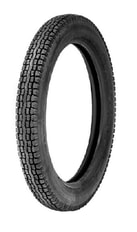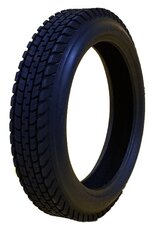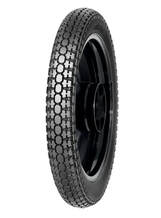With hardly any exceptions, motorcycles are delivered with tyres designed for solo motorcycles. Thousands and thousands of sidecar outfits have been built with the original motorcycle tyres fitted and have been run safely for millions of miles.
However, you will not move in the sidecar world long before you notice that many outfits are equipped with leading link forks (discussed elsewhere) and car tyres. And you will not ride sidecar combinations for long before you notice thet the wear rate, especially on the rear wheel, is far higher than it is for a solo motorcycle.
There are a few motorcycle tyres made specifically for sidecar duty:
Avon Triple Duty 3.50 x 19
Dunlop Racing 3.50 x 16
Heidenau K28 4.00 x 18 and 4.00 x 19
Metzeler Block K 4.00 x 18
Mitas h-2 Super Side 4.00 x 19
These all work well on classic machines, although the Dunlop is made in a soft compound and thus has a short life!
However, you will not move in the sidecar world long before you notice that many outfits are equipped with leading link forks (discussed elsewhere) and car tyres. And you will not ride sidecar combinations for long before you notice thet the wear rate, especially on the rear wheel, is far higher than it is for a solo motorcycle.
There are a few motorcycle tyres made specifically for sidecar duty:
Avon Triple Duty 3.50 x 19
Dunlop Racing 3.50 x 16
Heidenau K28 4.00 x 18 and 4.00 x 19
Metzeler Block K 4.00 x 18
Mitas h-2 Super Side 4.00 x 19
These all work well on classic machines, although the Dunlop is made in a soft compound and thus has a short life!
If you have a powerful machine and do high mileages, then car tyres may well be the answer and the initial outlay for special wheels will be repaid as the miles accumulate. There is an enormous range of car tyres available and the mileage obtained can be up to ten times that of a standard solo motorcycle tyre. Wheel modifications are not to be undertaken lightly and help from expert suppliers should be sought.
For several decades sidecarrists have been successfully fitting 15” tyres, firstly from 2CVs and then from Smarts, to sidecar outfits. There are, however a few pitfalls.
Firstly, as you can see from the table above, the 15” motorcycle rim is nearly 3 mm larger in diameter than the 15” car rim. (This is because car wheels and bicycle wheels have different histories.) If you fit a car tyre to a motorcycle rim you have to stretch the bead by 9 mm to get it on (2.86 x π) and you’ll have to use over 100 psi to achieve this and it’s dangerous! I think this has been fairly well recognised amongst sidecarrists in recent years, but I still come across cases of people struggling to fit car tyres to 15” bike rims.
As engine power and braking performance have increased tyres have got wider, and wide tyres on the front of an outfit make the steering heavier even if the trail is reduced, so there has been a movement recently toward fitting superscooter rear tyres to the front of outfits. A scooter tyre should only be fitted to a motorcycle rim. It will be slack on a car rim so it’s not just a matter of replacing the car tyre – you must replace the rim as well. It is likely that a scooter tyre will not stay on a car rim in the event of a puncture.
With 17” rims it’s the other way round: car tyres are loose on bike rims by 2.77 mm. Everyone has been so happy to find that the 17” car tyres are easy to fit, that they have not looked any further. The tubeless tyres are sealing satisfactorily probably because the bead, being 3.8 mm wider is sitting on the safety hump, which is closer to the edge on a bike rim (see table and diagram) and the problem with that is that, once again, the rim may not retain the tyre in the event of a puncture because the bead is already on top of the hump.
With 17” rims it’s the other way round: car tyres are loose on bike rims by 2.77 mm. Everyone has been so happy to find that the 17” car tyres are easy to fit, that they have not looked any further. The tubeless tyres are sealing satisfactorily probably because the bead, being 3.8 mm wider is sitting on the safety hump, which is closer to the edge on a bike rim (see table and diagram) and the problem with that is that, once again, the rim may not retain the tyre in the event of a puncture because the bead is already on top of the hump.
The difference of 0.25 mm between the diameters of 16” wheels really isn’t significant, but even then you must bear in mind that the car bead will not sit within the safety hump on the rim of a bike wheel and once again there is a risk of the tyre coming off its seating.
The only safe option is to fit car tyres to car rims and bike tyres to bike rims.
The only safe option is to fit car tyres to car rims and bike tyres to bike rims.







